
Although there are many lens choices for photographing birds, our discussion will focus on the medium length hand-holdable telephoto lenses.
When using the medium length telephoto lenses (e.g. Canon’s 300mm f4, Canon’s 400mm f5.6, Canon’s 100-400mm f4.5-5.6 and Nikon’s 200-400mm f4), it’s always advisable to use a tripod for the sharpest photographs possible. However, one type of photography virtually renders a tripod useless: photographing birds in flight and in particular, fast moving birds like raptors!
How to hold your camera
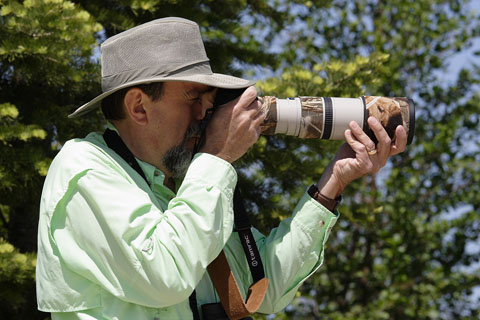
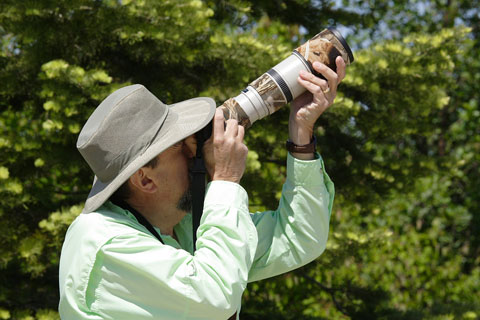
The two photos above show the proper way to hold your camera and lens. It’s important that your hands and entire body are in a relaxed position and that your position allows you to pivot easily. Confine your position and you’ll compromise your ability to move accurately as a bird weaves across the sky.
You will see in these photos that I have one hand firmly on the camera and the other hand relaxed at or near the end of the lens. This is the best way to have full balance and control of your movements.
In the first photo, I’m holding the camera in a somewhat level and horizontal position. Many times you’ll encounter a bird perched, and this position will allow you to not only take sharp photos of a stationary bird but also be ready if it takes flight and flies close to the ground.
In the second photo, I’m holding the camera for a bird in flight. You will notice that the position of my hands is virtually identical to the horizontal position. Again, it is important that your stance allows you to move in multiple directions, even to the point of almost turning around completely. Fast moving birds like hawks and falcons allow very little time for adjustments. So, being ready for their sudden shifts in direction is vital.
How to setup your camera
The next thing to consider is what camera settings to use. There are two mandatory requirements for shooting birds in flight:
Use a fast shutter speed, but don’t compromise good exposure or depth of field. Shutter speeds of 1/1000 or faster are recommended. Using high shutter speeds helps compensate for any minor unsteadiness and will also freeze the motion of the bird.
Maximize the burst rate on your camera. To maximize the amount of photos you can take in a burst, switch your camera to JPEG mode. Since JPEGs are significantly smaller than RAW, they won’t fill up your camera’s buffer as fast as RAW. Here’s a series of six photos that illustrate why a fast burst rate is important:


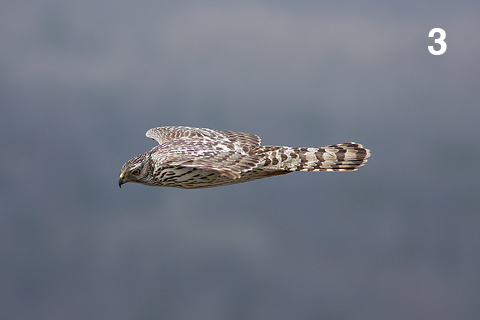
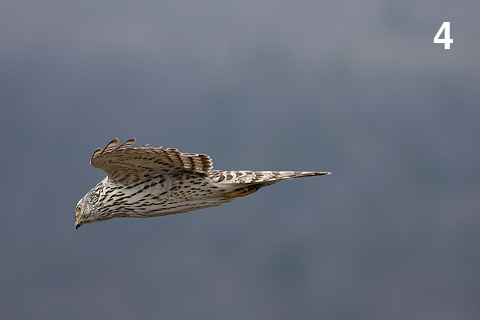
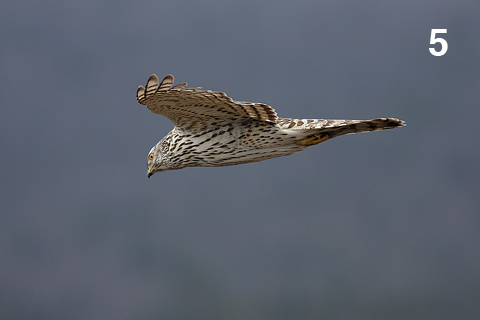
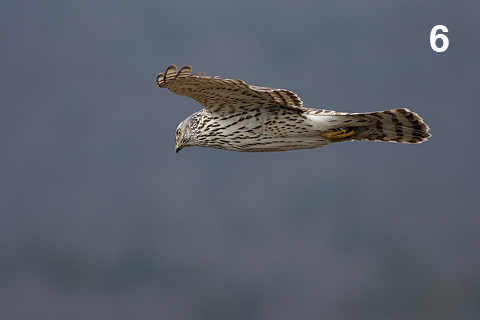
This sequence of six photos was taken with the camera set at the highest possible burst rate of 6 fps. The entire sequence of this shot lasted only 1 second total.
In general, there are three things to look for in a good bird image: sharpness, exposure and natural pose. Although all these shots were perfectly exposed, only one photo (#3) was both sharp and with the bird in a natural position. Had I not used a high burst rate, I may have missed this shot completely. And trying to get a bird in flight with a natural pose with only one shot being fired is pure luck. Take most of the luck out by using a high burst rate. This photo was shot with a Canon 300mm f/4L IS USM lens with the camera set at ISO 400 and f/4 at 1/2000 second. Oh, by the way, the bird is a juvenile Northern Goshawk.

Personally I like to set my camera in manual mode and use JPEG only.
Manual mode allows me to not worry about the camera changing settings as a bird moves past visible terrain of various shades or when the camera’s light meter misreads the scene such as when a bird moves in and out of your frame across a bright sky.
Shooting in JPEG lets me use the highest burst rate without any chance of the camera stalling as it sometimes does with RAW bursts. But keep in mind these are just my personal preferences. Plenty of bird photographers use either aperture priority or shutter priority along with RAW and achieve amazing results. Experiment and see what works best for you.
Just remember that your time of opportunity with a fast moving bird may only be a second or less!
Oh, and if you’re interested in learning more about raptors, please check out my new blog, The Raptorphile.
If you enjoyed this article, and would like to read more, please signup for free updates by email or RSS.
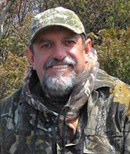 About the Author: Vic Berardi is a raptor lover that lives in the Midwest. He is the founder of the Illinois Beach State Park Hawk Watch and every weekend of the year you’ll find him searching for hawks and photographing them. Several of his photographs have been published in a leading raptor journal and in articles he has written. During the year he gives presentations teaching others about hawks and hawk migration. Vic also photographs dragonflies and wild flowers and is always respectful of nature and its creatures.
About the Author: Vic Berardi is a raptor lover that lives in the Midwest. He is the founder of the Illinois Beach State Park Hawk Watch and every weekend of the year you’ll find him searching for hawks and photographing them. Several of his photographs have been published in a leading raptor journal and in articles he has written. During the year he gives presentations teaching others about hawks and hawk migration. Vic also photographs dragonflies and wild flowers and is always respectful of nature and its creatures.
Hi, I have just bought a 5D mark II and I am using my 100-400mm lens as I am specifically wanting to shoot birds (we have hawks and Bald Eagles currently making regular appearnces in my local park!). I am mostly doing handheld for the very reason you point out-it’s almost impossible to shoot these moving targets on a tripod or monopod. My question is-which setting should I have my camera on if the shutter is to be set at 1/1000 and the ISO 400 ie TV,AV or M ? And how do I set my camera to take a “burst”? I used to own a Rebel and it had the litle “sports” setting which when you held down the shutter button gave you a burst. There is no such selection on the 5D and I am struggling to figure this out even with the manual?? Thanks ps I love your hawk photos:)
@ Mac, thank you and yes “practice and more practice” is great advice!!
@ Ian, thank you too! Not sure I would be able to help you but if you’d like to send me the photo, email me at VBirdman@aol.com
@ Caroline,
Excellent camera and lens! I will try to answer your questions as best as possible.
1) Setting your camera for burst mode:
On page 85 of your manual you want to follow the instructions for setting the camera in the “Continuous shooting” Make sure you see the image for this setting which looks like a staggered stacked deck of cards. Your camera shoots at a maximum of 3.9 frames per second which will be fine for birds in flight.
2) The question on how to set your camera is difficult to answer. Settings for proper exposure vary depending on light conditions. This is true no matter what mode you use, AV, TV or M. However, only in “M” do you have immediate full control. In “TV” or “AV” you’re bound to the camera’s metering of a scene unless you employ the exposure compensation feature. The “M” mode requires more thought but also gives you full control. Simply put, there is only one setting for exposure that is accurate!
Personally I shoot in full Manual exposure mode (M), which requires much patience in learning, to the point that your confidence level is very high that you can accurately set your camera at the proper exposure. I select my aperture first depending on the lighting. I select the smallest aperture I can that still allows me to have an acceptable shutter speed for birds in flight (for me that’s a minimum of 1/800 second.) Then I set the shutter speed.
I think Steve has previously posted something on learning Manual exposure here on the PhotoNaturalist. There is also info on the web and in books.
Hope some of what I said helps!
Vic
I appreciate the tips. You covered a lot, but left out focusing. Do you recommend AF or CAF (continuous AF)? I can’t see trying manual focus in this situation…
Thanks,
BGenie (shooting with Olympus e620)
Hi Vic,
Enjoy you site very much.
Bought the Canon 7d in January’12. Using with my Canon400mmf5.6 and its getting me great BIF shots. I now use jpeg with this camera and manual exposure in place of AV. Although I do go back to AV on occasions
Reasons for going back to jpeg are:
a. Downloading and editing Large Raw takes about 4mins a shot in DPP(Canon software)
b. As you say more burst shots
c. Cannot see much difference in Raw and jpeg shots for me to worry about!.
Regards
John
@ BGenie, I recommend CAF when following a bird in flight.
@ John, in the article I do recommend shooting in JPEG, but now that I’ve gotten used to my Canon 7D, I now shoot in RAW only mode and find it to be fine. Just make sure if you use RAW you don’t have the camera set for RAW and JPEG, that slows the burst rate down considerably But you’re correct, a well exposed JPEG image is usually all you will ever need and the burst rate is fastest in JPEG only mode.
Hi Vic,
I never set camera to take Raw+JPeg, only to check when I bought 7D.
I would like to go Large Raw but Canon DPP software takes far to long to edit (approx 4 minutes a shot) and adobe Elements 7 will not ID files!
Will I lose much in pictures quality going down to Medium Raw which don’t take long to download and edit in the Canon DPP software.
John
I would suggest using a different editing program like Lightroom 3 which B&H photo is offering today only for $69. With this program, you have many more tools to edit your images and is very good at managing your entire collection.
Love the tips! I don’t have the proper camera nor lens, but I still enjoy photographing birds. How do you work with the autofocus? Do you use an af lens? I have problems with sighting the bird in the sky. Sometimes I lose focus. Then I lose precious seconds trying to focus in on the bird again. Any tips for that? Thank you!
@ John, I would not recommend using anything but Large Raw. I use PS Elements 10 for my RAW conversion and it works fine.
@ Mac, excellent suggestion, I actually ordered Lightroom 3 from B&H the other day because of that sale!
@ Judy, what camera are you using?
Vic, I am using a Canon Rebel T3 with a 55-250mm IS lens. I am just practicing. Sometimes I can get a good shot, but mostly they’re too far away for my lens. I hate it when I’m tracking a bird in the sky and lose focus. I’ve managed to get a couple of nice shots of a bald eagle in the state park near my home, but out of 25 shots, there was only 1 real good one. The rest were all blurry or missed because of the focus. I’ve been searching for sites that can help make the most of what I have, and I was lucky enough to stumble in here!
Judy,
Your camera is capable of taking very high quality photos. However, the focal length of your zoom falls a tad bit short for most birds in flight. Larger birds, like the Bald Eagle you mention are fine, but even they need to be close to you.
As for the focusing issues, it is very difficult to stay on a bird that maneuvers around in the sky. Just try to anticipate the direction the bird is going as best as you could. No one gets every shot in focus.
Thank you for your time Vic! I went to the park this past weekend, and tried your tips you mentioned here. I managed to get quite a few nice shots off! I had been shooting in RAW, and changed it up to jpeg and used the settings you mentioned. I was able to get quite a few nice shots off of a few birds that were flying close to where I was! So I am pretty stoked! Thanks again!
Hi Vic,
Thanks so much for sharing your beautiful pictures and this very helpful advice. It seems that some photographers advocate for using the “center point” autofocus as opposed to alternatives such as “zone” or “expanded” autofocus points for bird in flight photos. The argument seems to be go ahead with the latter when the background is uniform such as sky as more focus points will make locking on the bird easier. But when the background is cluttered the camera may tend to get more easily confused and alternate between focusing on the bird or background. What are your thoughts about this?
thanks,
Jeff
Hi Jeff,
Thanks, glad you liked the post! On my Canon 7D I’ve used both the center point and the central array points (expanded) for birds in flight. Both work fine, however, I have noticed on occasion that there may be a slight lag in getting the bird in focus on the expanded AF points. I prefer to use the back focus button and the center point. Once I get the bird in focus (and on the center point) I take my thumb off the focus button momentarily and shoot a burst of photos.
Vic
This is a great website for nature shooters. I wish I had found it sooner.
Thanks Patricia! Glad you found it and glad you like it. Steve has lots of great tips to share and plenty more to come!
Hi Vic,
I’m just come across this web and found your great great advice.
I’m start taking bird pictures a year ago with several set up using my Nikon D90 then D7000 and now D4.
I’m no more than agree with you that using tripod and gimbal head never ever catch a flying bird.
Here in my Bangkok home town, birds are small to tiny and fast move either rest on a tree or flying.
I shall use your great advice to set up M mode with wide aperture, high ISO from 640 to 6400 as to get the maximum shutter from 2000.
My question is what should I set the exposure metering whether matrix, center weight or spot.
I learnt from your advice above that I should set auto focus mode to continuous. Again my problem is how to set the AF-area whether Single point AF, Dynamic area AF (9 or 21 or /51 points), 3D tracking, or auto area AF.
I’m perfectly agree with you that I should go for Jpg for fastest fps which I shall use utmost from my D4 10fps and dump files on to the new format XQD card which I doubt how many shooting series I could fire, well I should try it out.
Again big thanks for your tips and looking forward to hearing from you.
Oh, by the way, I found your article from my searching : “How to set up camera for bird shooting”
I have just taken a real interest in nature photography. My first venture into serious photography was gymanstics. I really learned a lot about taking fast action shots in various light conditions. I spent more than I should on equipment – Canon 7d, 70-200 f/2.8L, 135 f/2.0L, 1.4 and 2.0 extenders, etc. I got interested in birds this spring, but I don’t know a lot about taking good shots in the wild. We have several great parks with ducks, geese and swans. If anyone has any tips please share them. There is a reservior nearby with eagles and I would love to photograph them.
Hello, Thanks for the tips provided. Would appreciate if you can clarify, how to get the proper exposure. For example, in the picture at the top of this page, how does one ensure that the bird isnt underexposed/overexposed especially on a bright day? Would spot metering be the preferred metering mode? Would a circular polarizer help?
@ Max, sorry for the delay in getting back to you, just noticed your comment.
For metering mode, although I shoot almost 100% in Manual exposure mode, I set the meter to center weighted because occasionally I will try to get a reading on a neutral gray subject and centered weighted gives me the best results.
For AF, go with the center dot, and make sure you keep it on the bird, or use the back focus button to lock in AF while the bird is at the same distance from the camera. Also, try to anticipate the path the bird is taking to insure that dot stays on the bird.
@Jimphoto, cool, hope you get lots of stellar photos!
Hi Ramesh,
Because I shoot in Manual exposure mode I usually get a reading off a nearby object that is close to neutral gray in tone and use this as a starting point. Each bird will pose a different problem with exposure. Light colored birds with a good amount of lighting underneath is much different than a very dark bird. So, I generally set my aperture at the widest and use the thumb wheel for the shutter speed as the situation calls for. The shutter dial on my Canon is easily accessible to do this quickly.
The only time I would use a polarizer is on perched bird with my camera on a tripod.
Just great advise !
Thanks a lot VIC.
Will share u a picture once I get a good shot 🙂
Hi Vic,
I use a Cannon EOS 550-D and EFS 55-250mm IS telephoto lens. I am keen on taking close-ups of birds both at the bird feeder, but also in flight. I find the lens just a tad short on magnification and wish to upgrade. I have been looking at either the 100-400mm EF IS USM lens or using a 2x converter on a 55-300 EF IS lens. Because sharpness is important to me I was wondering which you would recommend. Your comments would be most appreciated.
Hi George,
Of the two lenses you’re considering I would recommend the 100-400. I’m not sure you could use a teleconverter on the 55-300 and even if you could you’d sacrifice speed and sharpness. The 100-400 is an excellent all around insect/wildflower/bird lens!
Hi again Vic,
Thanks for your comments. I guess I always though the 100-400 was the ideal lens for photographing birds, just wanted your recommendations to justify the expense. Good to know professional help from photographers with similar interests is available. Good snapping!!
Hi vic, wondering if you could help me. I am currently using a panasonic lumix DMC-FZ5 and i am trying to capture birds in flight as there are 2 red kites in my area at the moment. We captured some images a few days ago however they are nust not clear enough. We currently do not have a lens but are lookig into getting one in the near future. Do you have any tips for capturing birds in flight with this camera? Wod be very grateful if you could help me out. Thanks!
Leah,
Not sure the Lumix would focus quick enough for a bird in flight and also your shutter speed might be too slow. First see if you can get a shutter priority mode and set the shutter speed to at least 1/800 second then wait for the bird to circle or soar overhead.
Hope this helps!
Vic
Hi Leah,
I had the Panasonic DMC-FZ50 with a 1.7 tele extender. Took good pictures of birds close up but failed on birds in flight no matter what speed I tried. Pictures that I cropped seemed to go flat! I sold it on and bought a Canon 450d body with a Canon 400mm f5.6 and have not regretted it. Still have 400mm f5.6 along with the Canon 7d body.
Good luck,
John
Hi Vic,
I like your article very much. I have a Canon 100D And a tamaron 70-300mm lens. But I have not tried to photograph a bird so far. with the help of your article, i will now try .Thanks once again for a very good article.
Dilip
Thank you Dilip!
Great stuff Vic and killer photos! I might have missed it, but my best tip it to try to get birds flying at a 90 degree angle to you (i.e. left to right or vice versa) rather than directly towards you. As you pan with the bird, there is less change in the distance, so better chance to get good focus (vs a Peregrine Falcon coming straight at you at 100 miles an hour). Also, if you are in a situation where the birds are coming at you, get the wind at your back if at all possible. Bald Eagles going to the water to catch fish or birds landing on a perch generally do so going into the wind.
Thanks Steve! Your advice on wind direction is very important!!
Squatting is handy if you expect to have zenith shots. You can pivot your feet easily, and your center of balance is close to the ground. Shooting follow shots through the zenith is very difficult for me if I am standing, I either lose the bird or lose my balance.
Hi Vick,
Great site and you are helping confirm my move to get a 100-400mm. We have about 30-40 hummers and a slew of dragonflies and my 75-300mm is usm isn’t completely cutting it and with the hummers I would like to get more detail. I am shoot with a T3i and I know there are better bodies, but all the forums say upgrade the glass 1st. Thanks again for taking the time to put together such a great site dedicated to everything I like shooting!!
Regards,
Richard
Thank you Richard! Yes, concentrate on a high quality lens first.
Good luck, and I hope you get some awesome photos!
Lots of great info here. I use a 7d with 300 f4 and back focusing. When you are shooting a bird in flight, do you hit the AF on button once and shoot or keep your finger on the AF button? Im still trying to get that right. Thanks!
Sue,
Thanks! As for using the AF button, it depends. Usually I keep it depressed but if the lens drifts out of focus it may be quicker to re-achieve focus if you take your thumb off the button and press it again. But usually because you have such little time anyway, I recommend you keep your thumb on the button and more importantly concentrate on anticipating the bird’s movements so your focal point(s) stay on it for as long as possible.
I love the Photos. Can you explain metering. Even on spot metering , it’s a crap shoot.
I use a EOS7D and a canon 400 mm 5.6 L Great combo and lightning fast focus.
Hi Vic,
Just found your sight here and enjoyed reading your helpful tips and suggestions for shooting BIF.
I have seen many photographers offer advice for shooting birds and often disagree and actually scoff at much of it but found your remarks to be spot on.
I shot with a 7D and generally use a Canon 300 f 4 with a Canon 1.4 extender attached which gets me a 420 5.6. I have found this combination to produce quite accurate focus and detail.
I use the * button for BBF exclusively and found that for me anyway that’s the only way to go.
Feel free to check out my bird and alligator photo blog which is updated daily for examples of photos taken with the gear I mentioned.
http://phillanoue.com
Cheers
Phil
Great article about photographing birds in flight. I think settings sometimes can be personal choice. I do spend about 90% trying to photograph birds in filght. I use a Canon 1d mark3 and 1d mark2. Lense wise a Canon f/4 500mm with a teleconverter (x 1.4) and f2.8 300mm and depending on the situation sometimes bolt a x1.4 or x2 teleconverter. Now personally I prefer to use AV to manual and shoot in RAW also and on the custom functions I’ll switch from “main focus priority” to “continous AF track priority”, that’s Custom FN3 on the 1d Mark3. The “continous AF track priority” option I find particulary useful for slower moving birds in long grass like Owls as the focus doesn’t slip in out of focus so quickly
Hi Vic
I live in South Africa and have enjoyed ur website. I have a Canon EOS 550D and a Sigma 150-500 lens. I am thinking of buying a second camera so I don’t have to keep changing lenses. I am considering an EOS7D I would even consider an EOS 5D mark 3. Have read so many reviews which confuses matters. ie C frame vs Full frame. i want to take pictures of birds, I have many succesful shots wild life. I can get to within 50metres of some birds. I would appreciate your comments.-thanks
Ok, so I’m looking at photographing birds for a projrct that I’m doing for school. I was wondering about the burst rate… my camera only has one amount of bursts it can take, which is 4. Would that be enough to take pictures of a bird? Please help… thanks!!
Ok, so I’m looking at photographing birds for a projrct that I’m doing for school. I was wondering about the burst rate… my camera only has one amount of bursts it can take, which is 4. Would that be enough to take pictures of a bird? Please help… I would very much appreciate any feedback!
I decided to get an EOS 7D, the megapixel density is double that of the new EOS5D mk3. Besides 8fps is better than 6. I now walk about in the bush with a napsack on my back with 2 cameras. the 550D with an 18-200 lens and the 7D with a Sigma 150-500 lens. Am starting to get good clear shots of birds. Still playing with the autofocus points. The optometrist worked out how to set my viewfinder so I can work without my specs.
sir,
i hv a camera of sony s5000 nd its a simple one cox i can’t effort an expensive one so sir i request you to snd me the process of clicking the pictures of flying birds and olso sir i hv got some collectn too so if u wnt i cn snd dem out to you
For wildlife photos I have upgraded from a pentax 55-300 to a sigma 120-400. The Sigma has a built in motor to make focasing faster than the pentax could, the extra reach is good for all wildlife photography, it is sharper at 400mm than the pentax is at 300mm. If wildlife photography is what you do, get a 100-400mm lens for your setup you will not regret it.